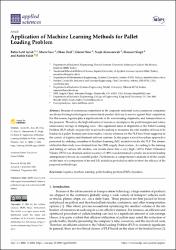| dc.contributor.author | Aylak, Batin Latif | |
| dc.contributor.author | İnce, Murat | |
| dc.contributor.author | Oral, Okan | |
| dc.contributor.author | Almasarwah, Najat | |
| dc.contributor.author | Singh, Manjeet | |
| dc.contributor.author | Salah, Bashir | |
| dc.contributor.author | Süer, Gursel | |
| dc.date.accessioned | 2022-01-11T07:12:25Z | |
| dc.date.available | 2022-01-11T07:12:25Z | |
| dc.date.issued | 2021 | en_US |
| dc.identifier.citation | Aylak, B. L., İnce, M., Oral, O., Süer, G., Almasarwah, N., Singh, M., & Salah, B. (2021). Application of Machine Learning Methods for Pallet Loading Problem. Applied Sciences, 11(18), 8304. | en_US |
| dc.identifier.issn | 2076-3417 | |
| dc.identifier.uri | https://hdl.handle.net/20.500.12846/624 | |
| dc.description.abstract | Because of continuous competition in the corporate industrial sector, numerous companies are always looking for strategies to ensure timely product delivery to survive against their competitors. For this reason, logistics play a significant role in the warehousing, shipments, and transportation of the products. Therefore, the high utilization of resources can improve the profit margins and reduce unnecessary storage or shipping costs. One significant issue in shipments is the Pallet Loading Problem (PLP) which can generally be solved by seeking to maximize the total number of boxes to be loaded on a pallet. In many previous studies, various solutions for the PLP have been suggested in the context of logistics and shipment delivery systems. In this paper, a novel two-phase approach is presented by utilizing a number of Machine Learning (ML) models to tackle the PLP. The dataset utilized in this study was obtained from the DHL supply chain system. According to the training and testing of various ML models, our results show that a very high (>85%) Pallet Utilization Volume (PUV) was obtained, and an accuracy of >89% was determined to predict an accurate loading arrangement of boxes on a suitable pallet. Furthermore, a comprehensive analysis of all the results on the basis of a comparison of several ML models is provided in order to show the efficacy of the proposed methodology. | en_US |
| dc.language.iso | eng | en_US |
| dc.publisher | MDPI-Multidisciplinary Digital Publishing Institute | en_US |
| dc.relation.isversionof | 10.3390/app11188304 | en_US |
| dc.rights | info:eu-repo/semantics/openAccess | en_US |
| dc.subject | Logistics | en_US |
| dc.subject | Machine Learning | en_US |
| dc.subject | Pallet Loading Problem (PLP) | en_US |
| dc.subject | Classifiers | en_US |
| dc.subject | Logistik | en_US |
| dc.subject | Maschinelles Lernen Palettenladeproblem | en_US |
| dc.subject | Klassifikatoren | en_US |
| dc.subject | Lojistik | en_US |
| dc.subject | Makine Öğrenme | en_US |
| dc.subject | Palet Yükleme Problemi | en_US |
| dc.title | Application of machine learning methods for pallet loading problem | en_US |
| dc.type | article | en_US |
| dc.relation.journal | Applied Sciences | en_US |
| dc.contributor.authorID | 0000-0003-0067-1835 | en_US |
| dc.identifier.volume | 11 | en_US |
| dc.identifier.issue | 18 | en_US |
| dc.relation.publicationcategory | Makale - Uluslararası Hakemli Dergi - Kurum Öğretim Elemanı | en_US |
| dc.contributor.department | TAÜ, Mühendislik Fakültesi, Endüstri Mühendisliği Bölümü | en_US |
| dc.contributor.institutionauthor | Aylak, Batin Latif | |
| dc.identifier.wosquality | Q2 | en_US |
| dc.identifier.scopusquality | Q2 | en_US |
| dc.identifier.wos | WOS:000699504600001 | en_US |

















